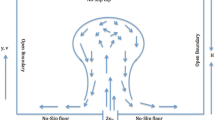Abstract
An analytic model to calculate evaporation from fetch-limited water bodies is described. By modifying the surface boundary condition to an analytic solution to the advection-diffusion equation for specific humidity in the air flow over a water body, we are able to solve for the entire specific humidity field q (x, z) from a single measurement of humidity, surface temperature, and wind speed. Comparisons of model predictions with measurements from Rushy Billabong, a small turbid lake, over a 146 day period show that on average the model underestimates evaporation rates by 12%. We believe that the evaporation shortfall is due to the downwind advection of heat within the billabong when the billabong is highly stratified in temperature. When the thermal stratification is weak, the advection of heat within the water column is less important and the model is an accurate predictor of evaporation.
Similar content being viewed by others
References
Abramowitz M, Stegun IA (1972) Handbook of mathematical functions. Dover, New York
Antonia RA, Luxton RE (1971) The response of a turbulent boundary layer to a step change in surface roughness, Part 1. Smoothto rough. J Fluid Mech 48:721–761
Antonia RA, Luxton RE (1972) The response of a turbulent boundary layer to a step change in surface roughness, Part 2. Rough to smooth. J Fluid Mech 53:737–757
Bradley EF (1968) A micrometeorological study of velocity profiles and surface drag in the region modified by a change in surface roughness. Quart J R Met Soc 94:361–369
Claussen M (1987) The flow in a turbulent boundary layer upstream of a change in surface roughness. Boundary-Layer Meteorol 40: 31–86
de Marsily G (1986) Quantitative hydrogeology. Academic Press, San Diego
Henderson-Sellers B (1986) Calculating the surface energy balance for lake and reservoir modelling: a review. Rev GeoPhys 24:625–649
Itier B, Brunet Y, McAneney KJ, Lagouarde JP (1994) Downwind evolution of scalar fluxes and surface resistance under conditions of local advection, Part 1. A reappraisal of boundary conditions. Agric For Meteorol 71:211–225
Itier B, Perrier A (1976) Présentation d'une étude analytique de l'advection. I. Advection liée aux variations horizontales de concentration et de température. Ann Agron 27:111–140
Liu WT, Katsaros KB, Businger JA (1979) Bulk parametrization of air-sea exchanges of heat and water vapor including the molecular constraints at the interface. J Atmos Sci 36:1722–1735
Mulhearn PJ (1978) A wind-tunnel boundary-layer study of the effects of a surface roughness change: rough to smooth. Boundary-Layer Meteorol 15:3–30
Panofsky HA, Dutton JA (1984) Atmospheric turbulence: models and methods for engineering applications. Wiley-Interscience, New York
Peterson EW (1969) Modification of mean flow and turbulent energy by a change in surface roughness under conditions of neutral stability. Quart J R Met Soc 95:561–575
Peterson EW (1972) Relative importance of terms in the turbulentenergy and momentum equations as applied to the problem of a surface roughness change. J Atmos Sci 29:1470–1476
Philip JR (1959) The theory of local advection. I. J Meteorol 16:535–547
Philip JR (1987) Advection, evaporation, and surface resistance. Irrig Sci 8:101–114
Rao KS, Wyngaard JC, Coté OR (1974) The structure of the two-dimensional internal boundary layer over a sudden change of surface roughness. J Atmos Sci 31:738–746
Sutton OG (1934) Wind structure and evaporation in a turbulent atmosphere. Proc R Soc Ser A 146:701–722
Taylor PA (1972) Wind profile development above a locally adjusted sea surface. Boundary-Layer Meteorol 2:381–389
van Wijk WR, de Vries DA (1963) Periodic temperature variations in a homogeneous soil. In: van Wijk WR (ed) Physics of plant environment, North-Holland, Amsterdam, pp 102–143
Weisman RN, Brutsaert W (1974) Evaporation and cooling of a lake under unstable atmospheric conditions. Water Resour Res 9:1242–1257
Weisman RN (1975) Comparison of warm water evaporation equations. J Hydr Div ASCE 101:1303–1313
Author information
Authors and Affiliations
Rights and permissions
About this article
Cite this article
Webster, I.T., Sherman, B.S. Evaporation from fetch-limited water bodies. Irrig Sci 16, 53–64 (1995). https://doi.org/10.1007/BF00189161
Received:
Issue Date:
DOI: https://doi.org/10.1007/BF00189161




